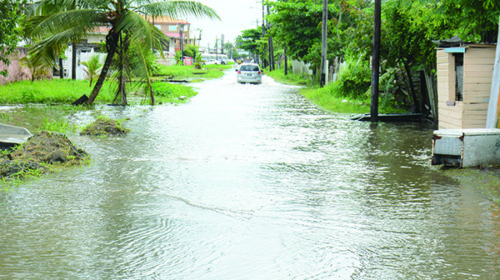
The Public Infrastructure Ministry is currently undergoing drainage works in Georgetown to ensure that accumulated water runs off promptly as the Ministry prepares for spring tides.
This is although some G$163 million was spent in April, by the National Drainage and Irrigation Authority (NDIA) to assist in reducing the occurrence of flooding.
The subject Minister, David Patterson in an interview with Guyana Times International on Wednesday said it was one of his “important” projects.
He explained, “I am working to ensure my full drainage network (is up) to deal with the spring tides. I am working to ensure we have everything covered”.
According to him, the works being done are vital as the spring tides are making it more difficult for accumulated water to recede.
“We have spring tide so obviously the water is higher on the outside so it has a reduced time for us to drain off so we are doing (checks) with additional pumps to run off but it’s coming along quite good,” he reported.
The Minister said some issues were encountered with two of the water pumps in Georgetown but were resolved.
He informed that works being done along Sussex and Commerce Street, Georgetown to ensure waters recede in a timely manner.
In the meantime, Patterson assured that waters along the East and West Coast are draining perfectly. He said, “East Coast is draining perfectly and over the river are doing really well. Georgetown of course, the low lying areas, they’re draining now but obviously the time period between the tides (is affecting it)”.
Patterson was keen to note that this exercise is not a costly one as pumps and other resources are being shifted around to benefit residents and commuters in the City.
In April, this newspaper reported on the costly project undertaken by the NDIA to reduce flooding in Georgetown. It was revealed that three high capacity mobile drainage pumps would be installed at Church Street, Sussex Street, and Ruimveldt to assist in reducing flooding.
The NDIA stated that the contracts have been approved for the cleaning of the city’s drainage channels, with manual cleaning operations totalling G$71.9 million and mechanical cleaning operations totalling G$91.6 million.
However, in May when the rainy season kicked in, several sections of the Capital city were flooded despite the costly works.
At several locations, vendors complained bitterly that every time it rained the streets become flooded and their businesses were affected although they pay their taxes to City Hall.
They protested that not only did the floodwaters affect them financially, they posed a health threat and made their working environment uncomfortable.
Nevertheless, the few customers who braved the weather were seen in their long boots and rain coats/umbrellas to ensure that their bills were paid among other things.
A study conducted by a European firm, Vivid Economics had found that some G$1.3 billion is lost every year in Georgetown as a result of flooding.
The lead consultant from the agency, Charlie Dixon, shared a few findings during his presentation, which indicated that not only was the vast sum a cause for concern presently but in years to come, as it was expected to increase significantly with oil production.
Dixon said, “At the present day, the risk of flooding is expected in the wider Georgetown area to cause around G$1.3 billion of damage every single year…so then as we look to 2040, looking into the future as climate change worsens and we expect these flooding effects to become more impactful, that number rises by … about a factor of four, so expected damage … [is] about G$4 billion.”



